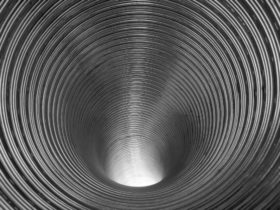The Process of Chimney Relining
Chimneys can last for generations, but chimney liners are another story. Chimney liners break down over time, which can put your home at risk of a chimney fire, or smoke or heat damage. Sometimes chimney liners are improperly sized for a fireplace system, which can cause problems with chimney draft and lead to smoke flooding back into a home. Chimney relining might also be called for when a new hearth appliance is hooked up to an existing chimney or when a new type of fuel is introduced to a fireplace or heating stove.
While the chimney itself is a basic architectural structure, the chimney liner bears the brunt of the work. Your chimney liner protects your home from the heat, smoke and flames put off by your fireplace. If you’ve been told that your chimney will need to be relined — whether it’s due to wear, drafting problems or a change in fireplace fuel — you don’t want to put it off. You might be wondering what that process looks like and what your chimney relining options are. At Your Chimney Sweep, we offer two primary types of chimney relining:
Stainless steel chimney liners
Stainless steel chimney liners are one of the most popular options for relining a chimney. They’re cost effective, easy to install and incredibly durable. If a liner is already in place, your chimney sweep will remove it. The new chimney liner, which will be properly sized for your hearth appliance, will then be attached to your fireplace or heating stove. Stainless steel chimney liners can be used to overlay a deteriorating masonry chimney liner, but they’re also a popular choice for resizing an improperly sized chimney liner to resolve drafting issues or to reline a chimney when the fireplace fuel type is changed.
HeatShield Cerfractory Sealant
Another popular tool for relining a chimney is HeatShield Cerfractory Sealant. HeatShield is a special cerfractory cement that can withstand the heat and flames of your fireplace. It can be used to restore the surface of a deteriorating masonry chimney liner or to line and unlined chimney. To apply heatshield, a foam plug specially sized for your chimney is lowered down the chimney flue. HeatShield is poured into the chimney, and the plug is pulled up with a winch. The plug smooths the HeatShield cement as it goes, filling in any cracks, holes or uneven surfaces in your chimney flue.
If your chimney needs to be relined; don’t put it off. Burning a fire in a fireplace attached to a deteriorating or insufficient chimney liner can put your home at risk of a dangerous fire or smoke or heat damage. Your Chimney Sweep can help! If your chimney needs to be relined, call Your Chimney Sweep to schedule an appointment today!


 home safe from the dangers of a chimney liner. Fortunately, when it comes to chimney liners, there’s a safe, durable and easy-to-install option that’s right for nearly ever chimney: the stainless steel
home safe from the dangers of a chimney liner. Fortunately, when it comes to chimney liners, there’s a safe, durable and easy-to-install option that’s right for nearly ever chimney: the stainless steel